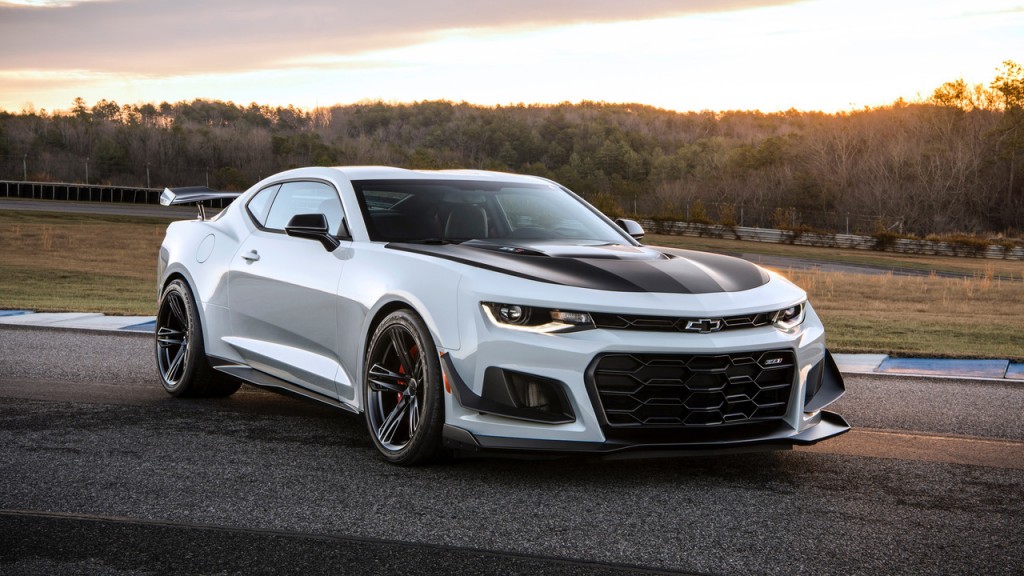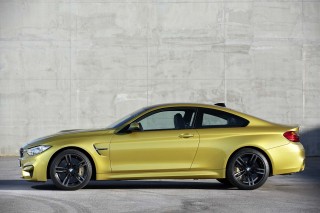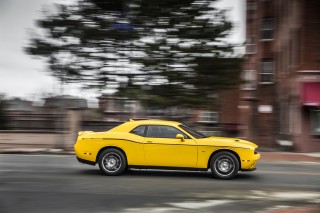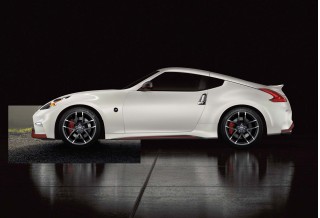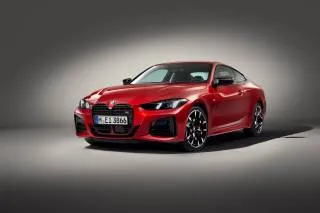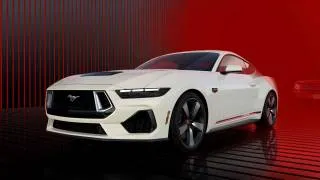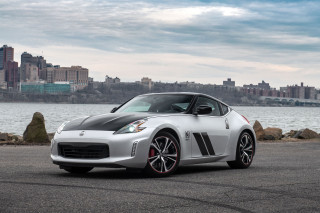Likes
- Shattering performance in SS form
- Tasty Alpha-platform components
- Magnetic Ride Control—amirite?
- A cockpit now made for adults
- Has its own light show
Dislikes
- Will the turbo-4 feel right?
- Rear seat is more of a parcel shelf
- Styling doesn't distance itself enough from previous generation
- Cockpit fits two—and only two—adults
Buying tip
features & specs
The 2017 Chevy Camaro is more than just a muscle car. It is now a true sports car, and the new 1LE and ZL1 performance versions only amp up the fun.
The Camaro celebrates its 50th anniversary for 2017, adding a massively powerful ZL1 model, a 1LE handling package, and a 50th Anniversary Edition package to this sporty coupe and convertible. Those versions join the turbo-4- or V-6-powered LT models and the V-8-powered SS models.
Also new for 2017 are a "FIFTY" badge on the steering wheel of all models, and a Teen Driver feature that allows parents to set controls and review driving habits. The ZL1 also comes with a new 10-speed automatic transmission.
The Camaro received a complete redesign last year, still using the retro-fantastic formula as before but with a modern twist. Underneath the car's new sheetmetal is General Motors' Alpha platform, the same architecture that underpins the Cadillac CTS and ATS, and the effect is staggering. No longer is the Camaro a straight-line muscle car; instead, much like the recent metamorphosis of its Mustang rival, the Camaro has transformed into a pure-bred performance car with exceptional handling and svelte moves.
Styling and Performance
When it was first revealed last year, the press and enthusiasts bemoaned the Camaro's redesign as a warmed-over iteration of its previous sheetmetal. However, the Camaro now wears a slightly smaller, tailored suit and it continues to ooze attitude and style. That's not to say it's perfect. From some angles, the Camaro cuts striking, honed lines, while other angles reveal a stubby, foreshortened body. It still wears its powerful haunches with the same pride, which nicely balance out its tall nose and slim grille. The menace? It's all there, intact, especially in dark colors.
But it wasn't the exterior that let down the last Camaro (unless we're talking about outward visibility, but more on that below). The car's cabin was its black mark, a mix of cheap materials and heritage design elements that didn't work in a modern interior. The new car fixes that. Fewer seams and high-quality materials combine for a more completely look.
Another thing that's gone with the new Camaro: weight—about 300 pounds of it in some versions. Thanks to the new Alpha platform, the Camaro has gone on a bit of a diet while simultaneously increasing its performance credentials. Beyond the basic structure, the Camaro also cribs its suspension and numerous body and mechanical components—namely engine rails, trunk floor, and steering gear—straight from the CTS-V to elevate handling while retaining the Camaro's classic, muscle-car stance.
For the first time in history, the Camaro gets a turbocharged four-cylinder engine, good for 275 horsepower, 295 pound-feet of torque, and a sprint to 60 mph in as few as 5.4 seconds.
The only problem is the sound, which isn't very macho. The V-6? It's rated at 335 hp and 284 lb-ft of torque, good enough to punt the Camaro to 60 mph in about five seconds. The Camaro's middle-child is potent enough to dust the highest-performance Camaros of just a decade ago. Still, it's the V-8 you really want. The Corvette's 455-horsepower LT1 V-8 is stuffed under the Camaro's hood, twisting 455 lb-ft of torque. It makes the SS a sensational piece of hardware, capable of 60-mph times of 4.0 seconds.
New for 2017 are the 1LE handling package and the 650-horsepower ZL1 with a supercharged version of the V-8. We haven't driven either, but we will report back when we have.
Interior, safety, and features
The new Camaro is now smaller than during its previous generation, which makes the back seat even more of a parvel shelf than what it was before. However, thanks to some tricky engineering work, drivers and front passengers have more room despite the new car's lower roof. Taller drivers can sit upright with a helmet on without hitting the headliner.
The government has not yet crash tested the Chevrolet Camaro, but the IIHS has. In IIHS testing, it received the top score of "Good" for the small front overlap, moderate front overlap, side, and rear crash tests, but it only got an "Acceptable" rating for the roof-strength test. It comes with a handful of active safety features, including forward-collision warnings, blind-spot monitors, and a standard rearview camera. It needs the latter, too, as outward vision is poor to the rear.
The Camaro's lineup is further broken down into 1LT, 2LT, 1SS, and 2SS models, as well as the ZL1. The 1LT and 1SS models come standard with a healthy set of features. The 1LE is an option package, and the ZL1 gets many of those features and then some.
Given all that, the Camaro is a tremendous value, especially at the SS level.
2017 Chevrolet Camaro Styling
The 2017 Chevrolet Camaro places style over function, with gun-slit windows that create a menacing look.
Sculping smaller cars is a tricky black art; lines have less room to play out, and that can make them abrupt instead of graceful.
We rate the Camaro an 8 for styling, giving it points for its interior and exterior designs, as well as another one for its iconic shape. (Read more about how we rate cars.)
Versus the fifth-generation Camaro, the Gen 6 car's exterior is updated, but the change isn't nearly as noticeable. GM attempted to maintain the Camaro's aggressive lines and profile while riding the body of the previous generation's more cartoon-ish flourishes. The result is a sports car that's striking from some angles and awkward from others. For instance, the sweeping rear roof pillar is gorgeous when seen in profile, but it makes the rear of the car look too short when viewed from a front 3/4 view. The front end, with its thin grille big intake, isn't as expressive as the previous car, but it's still full-on menacing—especially when viewed from the side.
The biggest drawback of the fifth-generation Camaro was its stark cockpit. Designers worked very effective change this time around. The new interior wears enhanced materials with fewer seams. The look is overall more cohesive and open thanks to lower placement of its dash and console. Gone are the heritage design details from the previous Camaro, replaced with a modern cockput with large digital gauges, a binnacle framed by "Star Wars" Tie Fighters, and gimbaled vents that bring futuristic, fresh style to an interior that will hopefully be appreciated for years to come.
2017 Chevrolet Camaro Performance
The Camaro may have the power of a muscle car, but it has the moves of a sports car.
The Camaro is far from the straight-line muscle car that Chevrolet debuted in 1967. The latest generation merges its infamous V-8 power with sophisticated driving dynamics to put it on par with some of the most capable performance cars ever. It really is a sports car now.
We rate the Camaro a 9 for performance, giving it points for steering, agility, acceleration, and braking. (Read more about how we rate cars.)
Accomplished dynamics
Along with being possibly the best Camaro in terms of handling, Chevrolet has fitted it with a Drive Mode Selector, altering the car's driving characteristics to suit different environments. The available modes—Sport, Tour, Snow/Ice, and Track (the latter available on SS and other performance variants)—change steering weight, shift timing, stability control, and throttle to make the Camaro as compliant or competitive as the situation warrants. Tour mode delivers lighter steering that's still quick and hefty compared to the over-boosted steering systems in non-performance cars. In Sport and Track modes, the Camaro could thread a needle with its precision. Thankfully, the new platform also rids the Camaro of the fifth-generation's oppressive understeer. Much of that improvement is credited to the components Chevrolet cribbed from Cadillac, such as suspension bits and a similar electric power steering system, that lighten the Camaro's nose.
Traction comes by way of Goodyear Eagle Sport tires wrapped around 18-inch wheels. Standard four-piston Brembo brakes bring everything to a stop in a hurry. Larger 20-inch wheels and Eagle F1 tires are available on LT models and standard on the SS.
The standard 18-inch wheels and tires don't bobble or dance too much, exhibiting a great sense of stability and good tracking. Broken pavement mid-corner is no longer a cause for concern as the Camaro now keeps its rear tires planted where they belong. Going two-sizes up to the 20-inch wheels, the Camaro begins to jackhammer and skitter over chunky, imperfect road surfaces. The SS is still able to keep its composure during times when posted speed limits are merely suggestions, but GM's magnetic dampers introduce a world of calm to the Camaro's demeanor here.
Dynamics promise to be even better in the 1LE and ZL1, but we haven't driven those cars yet.
A smorgasbord of engines
The base engine is a turbocharged 2.0-liter inline-4 that puts out 275 horsepower and 295 pound-feet of torque. Chevy pegs 0 to 60 mph times at 5.4 seconds. That's quite quick, and it may be a bit optimistic. Nonetheless, the 2.0 works well with both transmissions. The 6-speed manual has tidy throws and the clutch engagement feels more natural than it does with the 6.2-liter V-8. The 8-speed automatic shifts smoothly and is responsive enough that most drivers won't regret choosing it over the manual.
The one minor drawback of the turbo engine is the sound. It emits a low howl when pushed but is otherwise very docile. Most of us like a little more spice with our sports car gumbo.
Unlike Ford, Chevrolet continues to offer a V-6 on its sports car—and a good one at that. The latest iteration of GM's direct injection 3.6-liter V-6 is tuned to 335 horsepower and 284 pound-feet of torque, pegged at under 5 seconds in 0-60 mph runs. The V-6 emits a mid-range howl that's a bit vintage Ferrari, a little F1, but it's afflicted with the stereotypical V-6 drone as it approaches redline. Some of its noise is amplified and piped in from the engine bay.
But if you're seriously considering a Camaro, there are at least eight reasons to go big or go home. The 6.2-liter LT1 in SS models makes a very healthy 455 horsepower and 455 pound-feet of torque. Nail the throttle, and it feels like taking a 10-yard NFL pass right in the numbers. Power builds and the speedometer rises quickly, knocking off the 0 to 60 mph sprint in just 4.0 seconds. With either the stock rev-matching six-speed manual or the paddle-shifted eight-speed automatic, the SS is abundantly quick, feeling more composed of lean muscle than in its barrel-chested past. This is a transformative powertrain that does more than its share of work in turning the Camaro into a brutally powerful masterwork.
2017 Chevrolet Camaro Comfort & Quality
The front seats are supportive and the materials are up to snuff, but the 2017 Chevrolet Camaro's back seat is abysmal and the trunk is small.
The sixth-generation Camaro is a little smaller than the fifth, and that takes away a bit of interior space.
In our new rating system, we give the Camaro a point for the front seats, but take off a point for back-seat room, and for failing to give its four-seat design four usable seats. (Read more about how we rate cars.)
According to the spec sheet, the latest Camaro is 2.3 inches shorter than the last version, and more than 300 pounds lighter in some trim levels. It's almost an inch slimmer, at 74.7 inches wide, and sits more than an inch (1.1 to be precise) lower. Its wheelbase has shrunk 1.6 inches, to 110.7 inches.
Cabin space is allotted to the driver and front passenger better than the last-generation car, with much better head room. Even base-model cars sport shapely and supportive front seats that can be lowered more than before, meaning taller drivers in race helmets can usually fit.
The seats are form-fitting but in base trim wear a knit-nylon covering that's thrifty in look and feel. Pricey upgrades to Recaro seats with heating and ventilation are worthwhile spends.
Materials-wise, the Camaro still has an inexpensive look, but it is much better than the last-generation's plasticky cabin. Chevrolet saved space by nixing the CD player and replacing the traditional parking brake, opening up room for elbows and a big touchscreen. A pair of large, round vents incorporate climate controls in their outer rings.
If you're buying a Camaro, chances are you're not worried about rear-seat ammenities. And that's good, because the Camaro has approximately none. Rear-seat leg room is something that exists more on paper than it does in practice, though engineers did carve out an inch more head room from the headliner. It shouldn't be a surprise GM's engineers put little priority on rear-seat comfort in a smaller-than-before performance car. Want to negate the usefulness of the rear seat even more? Get the convertible, which has even less hip and shoulder room due to the power-operated convertible top. (At least it opens up for infinity headroom, right?) Instead, consider the rear seat a place to put things instead of people, especially considering tight confines of the Camaro's trunk.
2017 Chevrolet Camaro Safety
The 2017 Chevrolet Camaro has good crash test data, but it offers a few of today's active safety features.
The government has not yet crash tested the Chevrolet Camaro, but the IIHS has. In IIHS testing, it received the top score of "Good" for the small front overlap, moderate front overlap, side, and rear crash tests, but it only got an "Acceptable" rating for the roof-strength test, and that keeps it from earning the Top Safety Pick or Top Safety Pick+ awards.
The NHTSA gave the Camaro a five-star overall score, with a four-star rating for front crash safety.
We give it a 7 out of 10 for safety. (Read more about how we rate cars.)
GM brings some of its latest safety tech to the Camaro. Standard are a rearview camera and Bluetooth. Buyers can option forward-collision warning, rear parting sensors, and blind-spot monitoring. If you're looking for adaptive cruise or automated lane keeping, you're considering the wrong car.
The Camaro's an ode to high-strength steel and what it can do for safer car design. Finally, outward visibility is improved by way of slimmer pillars. But you'll certainly rely on that rearview camera; the Camaro's high tail demands it. A surround-view camera set would be welcome, too.
2017 Chevrolet Camaro Features
The base versions are well equipped and a $40,000 Camaro SS is an extraordinary performance value.
The Camaro is priced well for its available performance and equipment. Configuring one takes only a few steps through a simplified order sheet.
With good standard and optional features, good infotainment and lots of customization options, it earns an 8 for features. (Read more about how we rate cars.)
Five trims form the rungs of the Camaro ladder: 1LT, 2LT, 1SS, 2SS, and ZL1. All of those trims can be had in coupe and convertible form. But there is one exception. If you want the 1LE package, which can be added to LT and SS trims, you'll need to get a coupe as it's not available on convertible models.
The 1LT and 1SS models come with a well-rounded list of standard features: 18-inch wheels, power windows/locks/mirrors, rearview camera, cruise control, a six-speaker AM/FM audio system with a 7.0-inch touchscreen and audio streaming, Bluetooth, two USB ports, auxiliary jack, keyless ignition, power front seats, OnStar with subscription-based 4G LTE data services, and driver-selectable drive modes. The Camaro's infotainment system also supports Apple CarPlay and Android Auto.
2LT and 2SS trims add an upsized 8.0-inch infotainment touchscreen, dual-zone automatic climate control, upgraded Bose audio, and heated/ventilated front seats.
From LT to SS trims, Camaros get 20-inch wheels, Brembo brakes, performance suspension settings, heavy-duty cooling for the engine and transmission, and a limited-slip differential.
Among the major options are a dual-mode exhaust, Magnetic Ride Control dampers, navigation, head-up display, remote starting, heated steering wheel, sunroof, wireless phone charging, color-keyed interior trim, and ambient lighting.
An RS package for the LT models comes with 20-inch split 5-spoke wheels, 245/40R20 all-season run-flat tires, HID headlights, LED taillamps, a unique grille, and, on the coupe, a lip spoiler.
A 50th Anniversary package adds Nightfall Gray Metallic paint with a 50th Anniversary stripe, a "FIFTY" exterior badge, 50th Anniversary machined-face aluminum wheels and center caps, a body-color front splitter, orange front and rear calipers, Jet Black/Dark Gray front leather-trimmed seating with sueded accents and orange accent stitching, illuminated sill plates, and a 50th Anniversary treatment on the seatbacks and steering wheel.
The 1LE package for the LT features the SS model's FE3 suspension components, which includes the dampers, rear cradle mounts, ball-jointed rear toe links, and stabilizer bars. The SS's fuel system is included for higher-load cornering capability. It also gets lightweight 20-inch forged aluminum wheels with Goodyear Eagle F1 245/40R20 front and 275/35R20 rear tires, Brembo 4-piston front brake calipers, a mechanical limited-slip differential with a 3.27 gear ratio, and the dual-mode exhaust system. Inside it adds a suede-trimmed steering wheel and a short-throw shifter. On the outside, it has a satin black on the hood, front splitter, and three-piece rear spoiler, as well as a high-flow upper and lower grille with satin black accents.
The SS version of the 1LE package has many of the LT version's features, plus the magnetic dampers, an electronic limited-slip differential with a 3.73 gear ratio, 285/30ZR20 front and 305/30ZR20 rear tires, Brembo brakes with new 6-piston monobloc calipers and 14.6-inch two-piece rotors, and Recaro bucket seats. It also comes with the track-cooling package, with engine oil, differential, and transmission coolers. Exterior features include satin black on the hood, plus the front mirrors and rear spoiler, with satin graphite on the front splitter and rear diffuser.
The ZL1 goes even further. It comes standard with 11 heat exchangers for optimal powertrain cooling, a 6-speed manual transmission with rev matching or a new 10-speed automatic, the magnetic ride suspension, an electronic limited-slip differential, 20-inch forged aluminum wheels with 285/30ZR20 front and 305/30ZR20 rear Goodyear Eagle F1 Supercar tires, and Brembo brakes with 6-piston monobloc front calipers and 15.35-inch two-piece front rotors. The interior features Recaro front bucket seats, and a suede-trimmed flat-bottom steering wheel and shift knob. Standard safety features include rear park assist, rear cross-traffic alerts, and blind spot monitors with lane-change alert.
Chevrolet's Performance Data Recorder is available for the 1LE and ZL1.
2017 Chevrolet Camaro Fuel Economy
The 2017 Chevrolet Camaro offers 4-, 6-, and 8-cylinder engines, and fuel economy decreases as power goes up.
The 2017 Chevrolet Camaro offers a wide range of engines with fuel economy ratings that go up as the power goes down. The ratings are largely in line with its long-time rival, the Ford Mustang.
We rate the Camaro a 6 for fuel economy based on the ratings of its V-6 and 4-cylinder engines. (Read more about how we rate cars.)
For 2017, Chevrolet adds the 650-horsepower ZL1 model with a supercharged 6.2-liter V-8. It's the fastest Camaro and the thirstiest, with EPA ratings of 14 mpg city, 20 highway, 16 combined.
On the opposite end of the spectrum, the new 2.0-liter turbocharged inline-4 delivers the best fuel efficiency of the bunch. Paired with the automatic, the turbo mill achieves 22 mpg city, 31 mpg highway, and 25 mpg combined. Unfortunately, those numbers slip to 20/30/23 mpg with the turbo sending power through the available 6-speed manual.
With the SS's naturally aspirated V-8, fuel consumption isn't nearly as bad as you may think. The EPA estimates it at 17/27/20 mpg with the automatic transmission, and 16/25/19 mpg with the manual transmission.
For the V-6-powered Camaro, the automatic-equipped version is rated at 19/28/22 mpg. With the manual shifter, it drops to 16/28/20 mpg.
